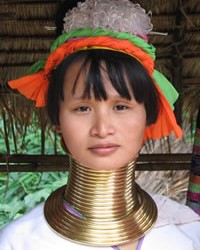Kayan, Padaung in Thailand

Photo Source:
Anonymous
|
Send Joshua Project a map of this people group.
|
| People Name: | Kayan, Padaung |
| Country: | Thailand |
| 10/40 Window: | Yes |
| Population: | 2,900 |
| World Population: | 148,900 |
| Primary Language: | Kayan (Myanmar) |
| Primary Religion: | Ethnic Religions |
| Christian Adherents: | 25.00 % |
| Evangelicals: | 2.50 % |
| Scripture: | Portions |
| Ministry Resources: | No |
| Jesus Film: | Yes |
| Audio Recordings: | Yes |
| People Cluster: | Karen |
| Affinity Bloc: | Tibetan-Himalayan Peoples |
| Progress Level: |
|
Introduction / History
The Padaung people live in the thick forests west of the Salween River and around the Pekon Hills, in Kayah State and southern Shan State of eastern Myanmar. Their traditional homeland is north-west of Loikaw town. Today they are concentrated in seven villages centered around their biggest village, Bangpe. Five hundred Padaung also live in Thailand, inhabiting three villages within Muang District of Mae Hong Son Province, very near the border with Myanmar. The Padaung first arrived in Thailand in 1988 when they fled fighting between Burmese troops and ethnic minorities in Kayah State.In their own language, Padaungs call themselves Kakaung, which means 'people who live on the hilltops'. The Padaung language is closely related to that of the Lahta tribe in Myanmar. It is part of the Karen branch of the Tibeto-Burman family.
What Are Their Lives Like?
For centuries, Padaung women have been a source of curiosity because of their custom of wearing up to 32 gold-colored brass neck coils. Once, they were even brought to the court in Mandalay for official inspection. In the past, girls adopted their neck rings on their fifth birthday and added one more coil each year until they were married. These days, the custom is fading in Myanmar. Women in only three villages reportedly still practice it.In Thailand, however, many Padaung women have continued the practice out of economic necessity. After their tribe moved into the country from Myanmar, they settled along the border, but they were prohibited from cultivating the land because they were not Thai citizens. Tourist agencies saw an opportunity to make money from the unusual appearance of the Padaung women. Hordes of camera-clicking tourists have flocked on pre-arranged visits to photograph the 'long neck' women, as they have come to be known.There are several theories surrounding the origins of the custom. Some say it was to protect the women from tiger attacks in the jungle, as tigers usually attack humans by biting their throats. Others claim that the Padaung are descended from swans, so they elongate their necks in a bid to look like their ancestors. 'Another tale records that the Padaung tribe was originally called Lae Khoe and ruled over the Burmese people. Later, the Burmese and ethnic groups joined forces to fight against the Lae Khoe and drove them off their land. During the war, a young Lae Khoe princess escaped. She wrapped the tribe's sacred gold-colored Padaung plant around her neck and declared that if the Lae Khoe failed to regain their land, she would never take it off. Since then, the Lha Khoe have been known as the Padaung. '
What Are Their Beliefs?
The Padaung's religious beliefs are a curious mix. One source says, 'The majority of the Padaung are Buddhists, but their religion is tempered with animist beliefs and practices.Due to the existence of a Roman Catholic mission for about 100 years in their homeland in Myanmar, some of the Padaung are Christians.
What Are Their Needs?
In Myanmar, they need protection from the military. In Thailand, they need the opportunity to learn new skills so they can thrive economically.
Prayer Points
Pray for their medical and educational needs to be met in abundance.Pray for the Holy Spirit to send a mighty revival to Padaung homes and churches.Pray for Padaung Christians to be filled with the fruit and the power of the Holy Spirit.Pray for Padaung Christians to excel in love, joy, and peace as they take Christ to others.Pray for them to have patience and kindness as they minister the gospel.